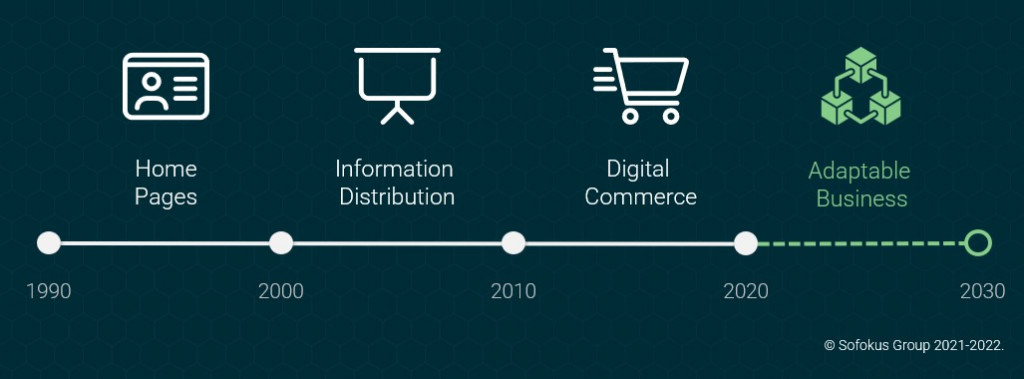
Adaptable Business
28 Feb 2022 • Strategy & Business Design, Trends & Signals
Software development, and in particular its use in business, is undergoing its biggest transformation since the turn of the millennium. This is the first part of a blog series in which I explain the reasons why Adaptable Business touches all organisations.
Decades of Digital Business Development
Business-driven digital development can be roughly divided into ten-year periods, each with a guiding trend. I will first introduce the decades of digital development trends and then explore adaptable business in more detail.

1990-2000: The Decade of Homepages
The mainstreaming of the internet took off before the turn of the millennium and the invention of graphical browsers broke the bank. The presence of businesses on the internet became an opportunity and websites of various organisations began to flood the web.
Home pages were an early precursor to modern websites, often virtual stopping places created by enthusiasts. They were like the first flag on the top of an previously unclimbable mountain. But the benefit for the pioneering organisations of digitalisation was mostly thin one-way street: a static business card.
Websites mainstreamed the internet.
2000-2010: The Decade of Dynamic Information Sharing
The pressure to open a website had started to build up for non-pioneering companies. Some organisations already felt they were getting business support online, so naturally the hunger grew. Organisations began to wonder if there was a more dynamic way of filtering information to their own stakeholders.
The concepts of intranet and extranet were coined, the former describing the distribution of information to one’s own organisation and the latter to subcontractors and alike. Filtering information dynamically to different stakeholders required, unlike a home page, actual programming alongside the HTML language. The need to create web-based systems began to grow. Organisations began to derive clear benefits from their dynamic systems, for example by providing their dealer network with up-to-date product material and price information.
The Internet started to become commercially interesting on a wider scale.
2010-2020: The Era of E-commerce
Naturally, as dynamic information sharing became more established, companies began to think more broadly about how to commercialise their online business more directly. As e-commerce software had become more sophisticated and cheaper – even free – with the advent of open source, the gold rush to e-commerce began.
Pretty much every able-bodied business opened its own online shop and the internet became a parlor trick in the minds of decision-makers. It was no longer the amusement of bright-eyed nerds, but a serious part of business development. Systems were increasingly integrated with core business systems (such as ERP) and the digital maturity of organisations reached 3/5.
E-commerce elevated the internet to a commercially level in the minds of most decision-makers.
2020-2030: The Decade of Adaptable Business
The debate on the digital leaps and digital transformation, which had been going on for several years, reached its climax in 2020 when the pandemic hit the world. The uncertainty of the VUCA world, the growing customer demand for digital services and the ever-changing landscape reached a peak as entire industries were forced to adapt in one fell swoop.
The economics of speed, teleworking and scenario planning became a mainstream topic of discussion regardless of the industry. How can an organisation improve its adaptability and, in particular, how can it do so at an accelerating pace? We have entered an era called adaptable business and it is forcing companies of all sizes to react ever faster to change.
According to McKinsey’s 2021 survey, only 11% of companies believe that their current business model will be fit for purpose by 2023, and 64% of companies believe that digital is the key to this transformation. The speed with which 2018 caught up with the market elite is dropping to a slower-than-average pace today.
Take a moment to digest the idea in the paragraph above. It means that unless your organisation’s adaptability continuosly evolve, your competitiveness will inevitably suffer. The good news is that there are solutions for improving your adaptability.
We are currently living the era of Adaptable Business.
Characteristics of an Adaptive Organisation
Adaptive business puts new demands on your business. First, it requires cultural adaptation, such as adapting to rapid experimentation or a guided self-organization model. Second, adaptive business requires a higher degree of modularity in your digital infrastructure than what you were used to in previous decades.
In fact, a high level of digital maturity can be seen as one of the clear hallmarks of an adaptive business. A company operating at digital maturity level 3 is unlikely to be an adaptive organisation. Adaptability requires an experimental organisational culture and an API-driven digital architecture, whereas a level 3 company is likely to have purchased a traditional ERP system and connected it to monolithic e-commerce software.
It is also worth noting that even an organisation operating at the highest levels of digital maturity (4-5) may not be sufficiently adaptable. In fact, adaptability imposes one new requirement on companies that I call the adaptive digital heart. In the next parts of this blog series, I will explain in more detail what this means in practice. Check out Forbes’ 15-point list of business adaptability.
An adaptive organisation has an adaptive digital heart & organisation culture.
Stay tuned to learn more about adaptable business
This is the first part of the adaptable business blog series, which covers more of a general background. In the following parts, I will discuss one by one the phenomena and requirements that adaptability affects in your business and in particular how you respond to this in your organisation.
Part 1: Adaptable Business (this blog post)
Part 2: What is Composable Business?
Part 3: What is Composable Commerce?
Part 4: What is Low-code and No-code?
Part 5: What is Culture of Experimentation?






